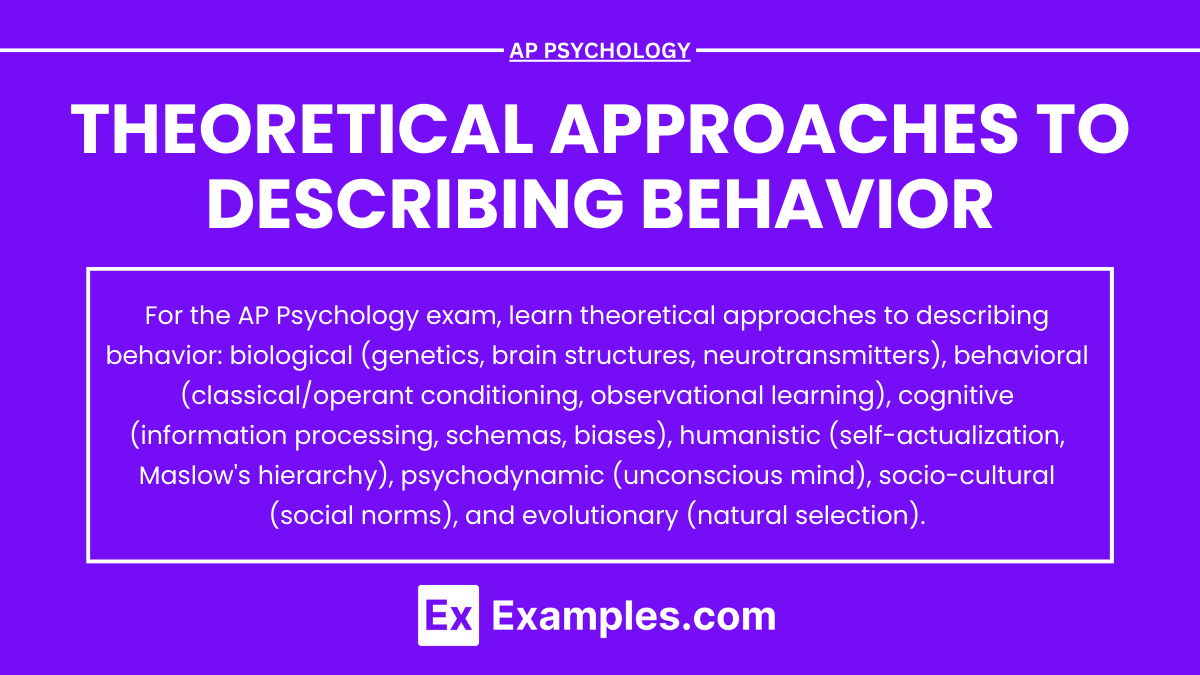In AP Psychology, understanding the different theoretical approaches to describing behavior is crucial for achieving a high score. These approaches provide various perspectives on human behavior, each with its own unique focus and methodology. Here are the major theoretical approaches you need to know
Learning Objectives
To excel in the AP Psychology exam, understand these theoretical approaches: biological (genetics, brain structures, neurotransmitters), behavioral (classical/operant conditioning, observational learning), cognitive (information processing, schemas, biases), humanistic (self-actualization, Maslow’s hierarchy, client-centered therapy), psychodynamic (unconscious mind, defense mechanisms, early experiences), socio-cultural (social norms, cultural influences), and evolutionary (natural selection, adaptive behaviors). Mastering these concepts and key studies is crucial for success.
Biological Approach
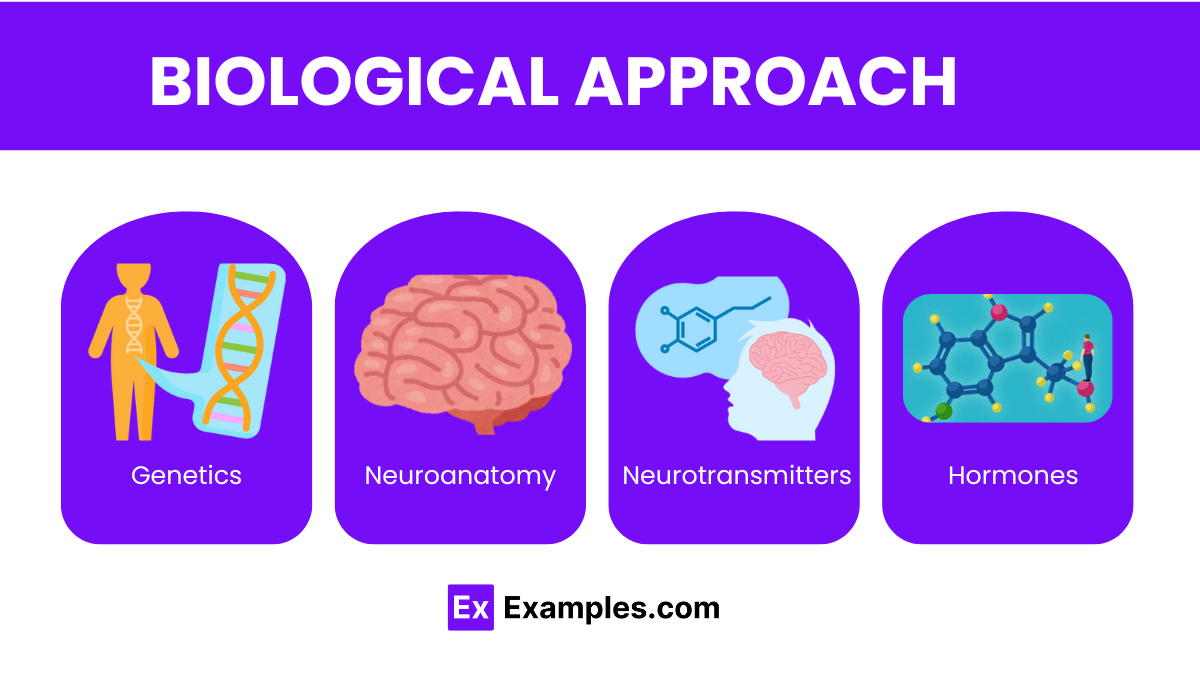
The biological approach in psychology emphasizes the influence of biological processes and structures on behavior, thoughts, and emotions. This approach integrates insights from various biological sciences to understand how the brain, nervous system, and other physiological systems impact psychological functioning.
1. Genetics
Definition: Genetics studies how inherited traits and genetic predispositions affect behavior and mental processes.
Key Concepts:
- Genes: Units of heredity that contribute to a person’s characteristics.
- Heritability: The extent to which differences in a trait across individuals are due to genetic factors.
- Genetic Disorders: Conditions caused by abnormalities in the genome (e.g., schizophrenia, bipolar disorder).
Examples:
- Twin studies help understand the heritability of traits like intelligence and personality.
- Research on genetic markers associated with mental disorders.
2. Neuroanatomy
Definition: Neuroanatomy involves studying the structure and function of the nervous system and brain.
Key Concepts:
- Neurons: Basic building blocks of the nervous system that transmit information.
- Brain Structures: Different areas of the brain responsible for various functions (e.g., amygdala, hippocampus, prefrontal cortex).
- Neural Pathways: Networks of neurons that work together to process and transmit information.
Examples:
- The amygdala is involved in emotional responses, especially fear.
- The hippocampus plays a critical role in forming new memories.
3. Neurotransmitters
Definition: Neurotransmitters are chemical messengers that transmit signals across synapses between neurons.
Key Concepts:
- Dopamine: Involved in reward, motivation, and pleasure.
- Serotonin: Regulates mood, appetite, and sleep.
- Acetylcholine: Involved in learning and memory.
- GABA: An inhibitory neurotransmitter that reduces neuronal activity.
Examples:
- Low levels of serotonin are linked to depression.
- Dopamine imbalances are associated with schizophrenia and Parkinson’s disease.
4. Hormones
Definition: Hormones are chemical substances released by glands that regulate various body functions and behaviors.
Key Concepts:
- Endocrine System: Glands that secrete hormones into the bloodstream.
- Adrenaline: Increases arousal and prepares the body for a fight-or-flight response.
- Cortisol: Released in response to stress, helps regulate metabolism and immune response.
- Oxytocin: Involved in social bonding, childbirth, and lactation.
Examples:
- High levels of cortisol are associated with chronic stress and anxiety.
- Oxytocin promotes bonding between mothers and their infants.
Biological Research Methods
1. Brain Imaging Techniques
- MRI (Magnetic Resonance Imaging) : Creates detailed brain images using magnetic fields.
- fMRI (Functional MRI) : Measures brain activity via blood flow changes.
- PET (Positron Emission Tomography) : Visualizes brain activity using radioactive tracers.
- EEG (Electroencephalogram) : Records electrical activity in the brain.
2. Genetic Studies
- Twin Studies : Compare identical and fraternal twins to assess genetic influence.
- Adoption Studies : Compare adopted individuals to biological and adoptive parents.
- Genome-Wide Association Studies (GWAS) : Analyze genomes to find genetic variations linked to traits.
3. Pharmacological Studies
- Drug Effects : Study how medications impact brain function.
- Neurochemical Modulation : Examine changes in neurotransmitter levels.
Behavioral Approach
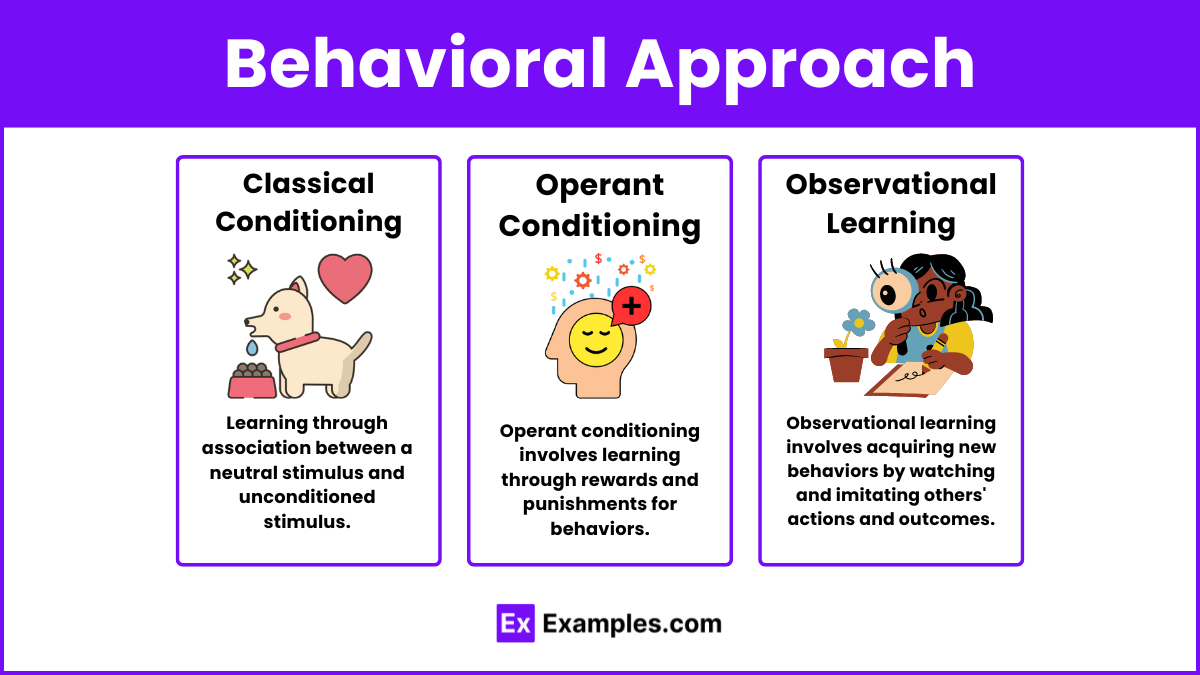
1. Classical Conditioning
Definition: Classical conditioning is a learning process that occurs through associations between an environmental stimulus and a naturally occurring stimulus.
Key Concepts:
- Unconditioned Stimulus (US): A stimulus that naturally and automatically triggers a response (e.g., food).
- Unconditioned Response (UR): An unlearned, naturally occurring response to the unconditioned stimulus (e.g., salivation).
- Conditioned Stimulus (CS): A previously neutral stimulus that, after becoming associated with the unconditioned stimulus, triggers a conditioned response (e.g., bell).
- Conditioned Response (CR): A learned response to the conditioned stimulus (e.g., salivation to the bell).
Example:
- Pavlov’s Dogs: Ivan Pavlov conditioned dogs to salivate at the sound of a bell by repeatedly pairing the bell (CS) with food (US).
2. Operant Conditioning
Definition: Operant conditioning is a method of learning that occurs through rewards and punishments for behavior. It involves an association between a behavior and its consequences.
Key Concepts:
- Positive Reinforcement: Adding a pleasant stimulus to increase a behavior (e.g., giving a treat for sitting).
- Negative Reinforcement: Removing an unpleasant stimulus to increase a behavior (e.g., turning off loud noise when desired behavior occurs).
- Positive Punishment: Adding an unpleasant stimulus to decrease a behavior (e.g., scolding for misbehavior).
- Negative Punishment: Removing a pleasant stimulus to decrease a behavior (e.g., taking away a toy for misbehavior).
Example:
- Skinner’s Box: B.F. Skinner used a box to study how rats learned to press a lever (behavior) to receive food (positive reinforcement).
3. Observational Learning
Definition: Observational learning, also known as social learning, occurs when individuals learn by observing the behaviors of others and the consequences of those behaviors.
Key Concepts:
- Modeling: The process of observing and imitating a specific behavior.
- Vicarious Reinforcement: Learning by observing the reinforcement or punishment of others’ behaviors.
Example:
- Bandura’s Bobo Doll Experiment: Albert Bandura demonstrated that children could learn aggressive behaviors by observing an adult model behaving aggressively towards a Bobo doll.
Cognitive Approach
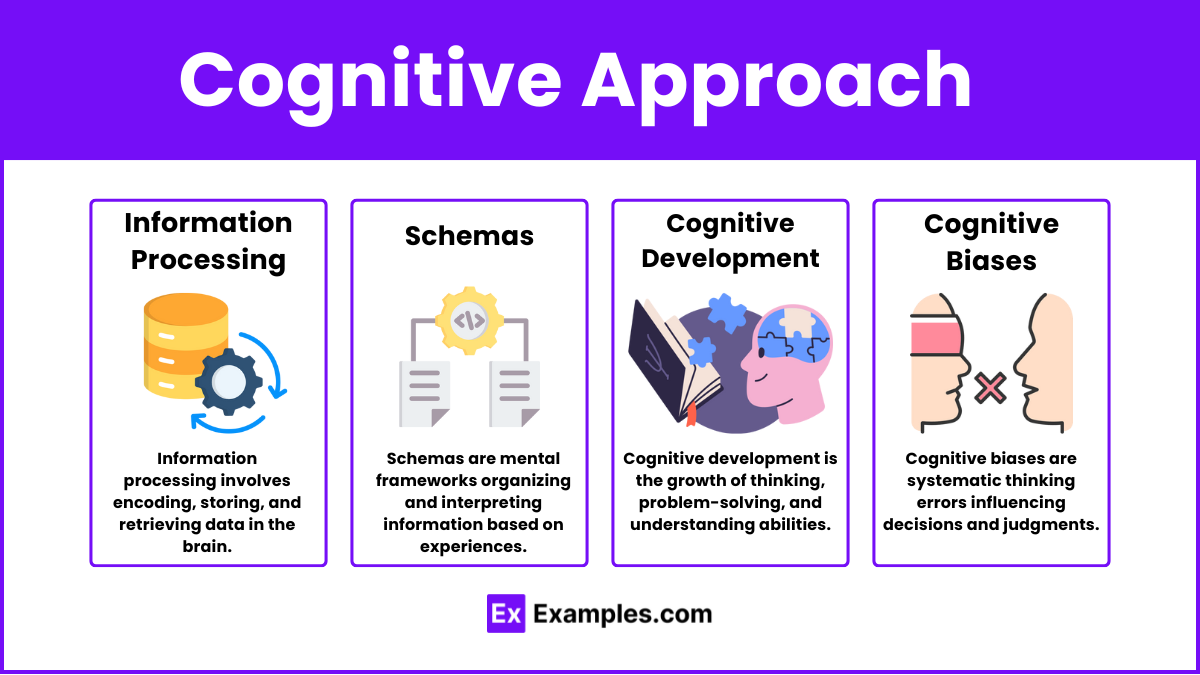
1. Information Processing
Definition: Information processing is a framework used to describe how humans perceive, analyze, manipulate, store, and retrieve information.
Key Concepts:
- Encoding: The process of converting information into a form that can be stored in memory.
- Storage: The retention of encoded information over time.
- Retrieval: The process of accessing and bringing stored information into consciousness.
Example:
- Using the multi-store model of memory, which includes sensory memory, short-term memory, and long-term memory.
2. Schemas
Definition: Schemas are mental frameworks that help organize and interpret information based on past experiences and knowledge.
Key Concepts:
- Assimilation: Integrating new information into existing schemas.
- Accommodation: Modifying existing schemas to incorporate new information.
- Scripts: Schemas for specific types of events or activities.
Example:
- A child’s schema for dogs includes the characteristics “four legs” and “barks.” When the child encounters a new type of dog, they assimilate this information into their existing schema.
3. Cognitive Development
Definition: Cognitive development refers to the changes in cognitive processes and abilities across the lifespan.
Key Concepts:
- Stages of Development: Theories like Piaget’s stages of cognitive development outline how thinking evolves in distinct stages.
- Sensorimotor Stage: Birth to 2 years; learning through sensory experiences and manipulating objects.
- Preoperational Stage: 2 to 7 years; developing language and symbolic thinking.
- Concrete Operational Stage: 7 to 11 years; logical thinking about concrete events.
- Formal Operational Stage: 12 and up; abstract and logical thinking.
Example:
- Children in the preoperational stage struggle with the concept of conservation, understanding that quantity remains the same despite changes in shape.
4. Cognitive Biases
Definition: Cognitive biases are systematic patterns of deviation from norm or rationality in judgment.
Key Concepts:
- Confirmation Bias: Tendency to search for, interpret, and remember information that confirms one’s preconceptions.
- Anchoring Bias: Relying too heavily on the first piece of information encountered (the “anchor”) when making decisions.
- Availability Heuristic: Overestimating the likelihood of events based on their availability in memory.
Examples:
- Studying how memory works using models like the multi-store model.
- Investigating cognitive biases such as the confirmation bias.
Humanistic Approach

1. Self-Actualization
Definition: Self-actualization is the process of realizing and fulfilling one’s potential and capabilities. It is considered the pinnacle of personal growth and development.
Key Concepts:
- Maslow’s Hierarchy of Needs: A pyramid of human needs, with basic needs at the bottom and self-actualization at the top.
- Physiological Needs: Basic survival needs like food and water.
- Safety Needs: Security and protection.
- Love and Belongingness Needs: Relationships and social connections.
- Esteem Needs: Self-esteem and recognition.
- Self-Actualization: Achieving one’s full potential and creativity.
Example:
- A person who has satisfied their basic and psychological needs might pursue personal passions and creativity, achieving self-actualization.
2. Unconditional Positive Regard
Definition: Unconditional positive regard involves accepting and valuing a person without conditions or judgments. It is a crucial element of the therapeutic relationship in humanistic therapy.
Key Concepts:
- Acceptance: Valuing individuals for who they are.
- Empathy: Understanding and sharing the feelings of others.
- Genuineness: Being authentic and transparent in interactions.
Example:
- A therapist offers unconditional positive regard to a client, creating a safe and supportive environment for personal growth.
3. Client-Centered Therapy
Definition: Client-centered therapy, developed by Carl Rogers, is a non-directive form of talk therapy that emphasizes the client’s capacity for self-direction and understanding of their own development.
Key Concepts:
- Non-Directive Approach: The therapist does not guide or direct the session but supports the client in exploring their feelings and thoughts.
- Empathetic Understanding: The therapist actively listens and empathizes with the client.
- Therapeutic Alliance: A strong, trusting relationship between therapist and client.
Example:
- In client-centered therapy, a therapist listens without judgment and helps the client explore their feelings and thoughts, facilitating self-discovery and growth.
4. Personal Growth and Fulfillment
Definition: Personal growth involves the ongoing process of understanding and developing oneself to achieve one’s fullest potential.
Key Concepts:
- Self-Exploration: Reflecting on personal experiences, values, and beliefs.
- Self-Efficacy: Believing in one’s ability to succeed.
- Autonomy: Making independent choices and decisions.
Example:
- An individual sets personal goals, engages in self-reflection, and takes steps towards self-improvement and fulfillment.
Psychodynamic Approach

1. The Unconscious Mind
Definition: The unconscious mind contains thoughts, memories, and desires that are not within conscious awareness but influence behavior.
Key Concepts:
- Id: The part of the personality driven by primal urges and desires (pleasure principle).
- Ego: The rational part that mediates between the id and reality (reality principle).
- Superego: The moral component that incorporates societal rules and values.
Example:
- Repressed memories of childhood trauma can influence adult behavior unconsciously.
2. Defense Mechanisms
Definition: Defense mechanisms are unconscious strategies used by the ego to protect against anxiety and maintain psychological stability.
Key Concepts:
- Repression: Pushing distressing thoughts into the unconscious.
- Denial: Refusing to accept reality or facts.
- Projection: Attributing one’s own unacceptable feelings to others.
- Displacement: Redirecting emotions to a safer outlet.
- Rationalization: Justifying behaviors with logical reasons.
Example:
- A person who experiences childhood abuse might repress those memories and later exhibit anxiety without knowing the cause.
3. Psychosexual Stages
Definition: Freud proposed that personality develops through a series of childhood stages where pleasure-seeking energies focus on different erogenous zones.
Key Concepts:
- Oral Stage: Birth to 18 months; pleasure centers on the mouth (sucking, biting).
- Anal Stage: 18 months to 3 years; pleasure focuses on bowel and bladder control.
- Phallic Stage: 3 to 6 years; pleasure zone is the genitals; coping with incestuous feelings (Oedipus complex).
- Latency Stage: 6 to puberty; dormant sexual feelings.
- Genital Stage: Puberty onward; maturation of sexual interests.
Example:
- Fixation at the oral stage may result in behaviors such as smoking or overeating in adulthood.
4. Early Childhood Experiences
Definition: Early childhood experiences significantly shape personality and behavior in adulthood.
Key Concepts:
- Attachment: The emotional bond between a child and caregiver, influencing future relationships.
- Parenting Styles: Different approaches to parenting affect a child’s development (authoritative, authoritarian, permissive).
Example:
- A child with an insecure attachment may develop trust issues and struggle with relationships later in life.
5. Interpersonal Relationships
Definition: Interpersonal relationships and interactions with others play a critical role in shaping personality and behavior.
Key Concepts:
- Transference: Redirecting feelings for one person onto another, often seen in therapy.
- Object Relations: The study of how people internalize and form attitudes toward others based on early relationships.
Example:
- A person may transfer unresolved feelings towards a parent onto their therapist, impacting the therapeutic process.
Socio-Cultural Approach
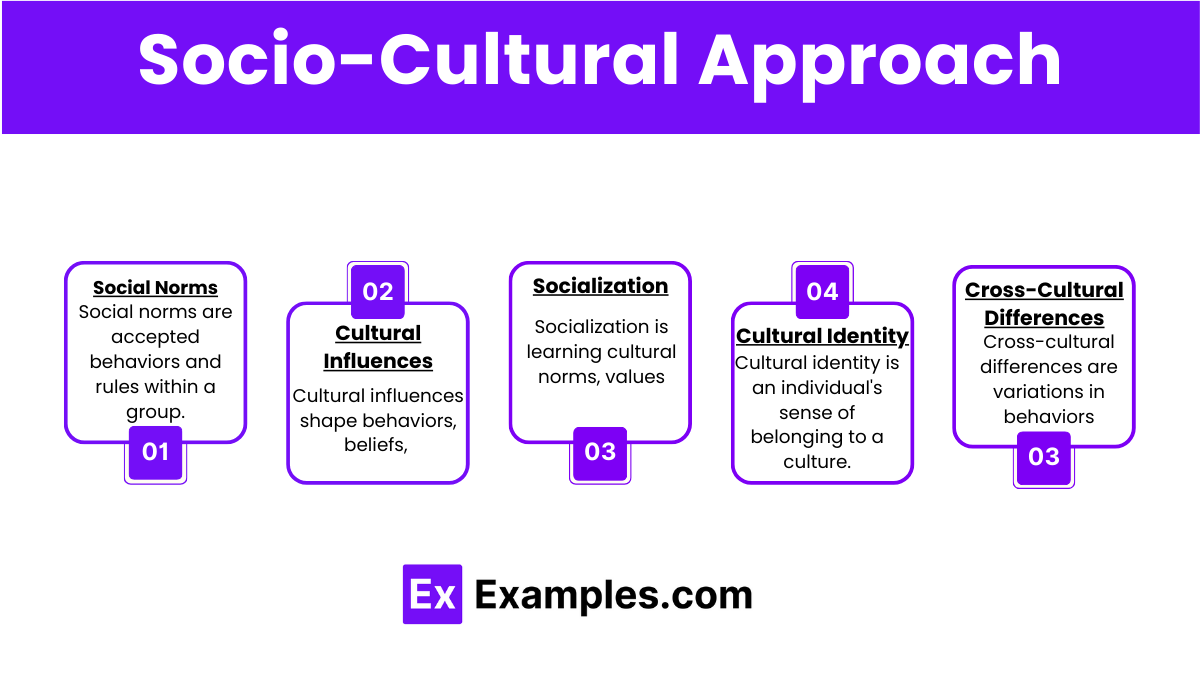
1. Social Norms
Definition: Social norms are the accepted behaviors and beliefs within a society or group.
Key Concepts:
- Conformity: Adjusting behaviors or attitudes to align with group norms.
- Social Influence: The effects of others on an individual’s behavior.
- Role Expectations: The behaviors expected of individuals in specific social positions.
Example:
- People tend to dress similarly within a given culture due to social norms.
2. Cultural Influences
Definition: Cultural influences refer to the impact that a person’s culture has on their behavior and thinking.
Key Concepts:
- Individualism vs. Collectivism: Individualistic cultures emphasize personal goals, while collectivist cultures emphasize group goals.
- Cultural Relativism: Understanding behaviors and practices within the context of the culture in which they occur.
- Cultural Norms: Shared expectations and rules guiding behavior in a specific culture.
Example:
- In individualistic cultures, personal achievement is highly valued, while in collectivist cultures, harmony and group cohesion are prioritized.
3. Socialization
Definition: Socialization is the process by which individuals learn and adopt the behaviors and norms of their culture.
Key Concepts:
- Primary Socialization: Occurs during childhood through family and close contacts.
- Secondary Socialization: Occurs through external influences such as schools, peers, and media.
- Agents of Socialization: Influences like family, schools, peers, and media that shape an individual’s social development.
Example:
- Children learn language, social norms, and values from their families and schools.
4. Cultural Identity
Definition: Cultural identity refers to an individual’s sense of belonging to a particular culture or group.
Key Concepts:
- Ethnic Identity: A person’s identification with a racial or ethnic group.
- Acculturation: The process of adapting to a new culture while maintaining aspects of the original culture.
- Biculturalism: The ability to navigate and identify with two distinct cultures.
Example:
- An immigrant might retain their native language and customs while also adopting aspects of their new country’s culture.
5. Cross-Cultural Differences
Definition: Cross-cultural differences refer to the variations in behaviors, beliefs, and values across different cultures.
Key Concepts:
- Cross-Cultural Psychology: The study of similarities and differences in behavior across different cultures.
- Cultural Dimensions: The frameworks for understanding cultural differences, such as Hofstede’s cultural dimensions theory.
- Ethnocentrism: Judging another culture solely by the values and standards of one’s own culture.
Example:
- Research comparing parenting styles across different cultures highlights varying approaches to discipline and child-rearing.
Evolutionary Approach
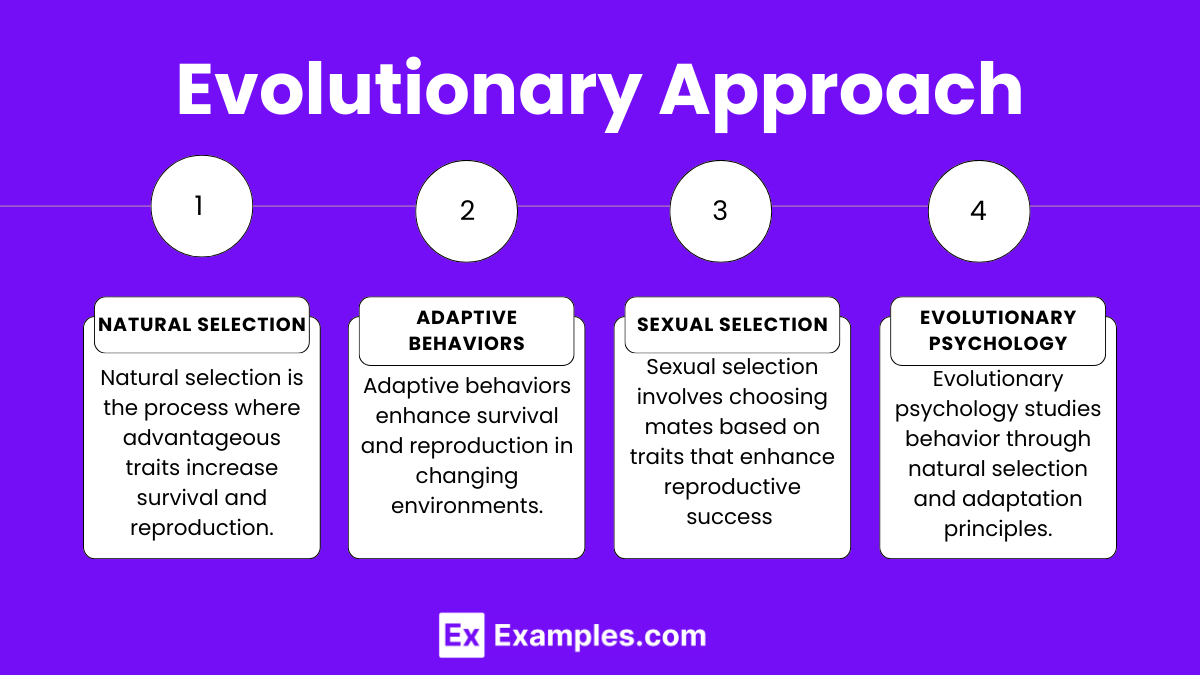
1. Natural Selection
Definition: Natural selection is the process by which traits that enhance survival and reproduction become more common in successive generations.
Key Concepts:
- Survival of the Fittest: Individuals with advantageous traits are more likely to survive and reproduce.
- Adaptation: Traits that increase an individual’s fitness in a specific environment.
- Reproductive Success: The passing of genes to the next generation.
Example:
- Human preference for sweet and fatty foods may have developed because these foods were calorie-dense and beneficial for survival in ancestral environments.
2. Adaptive Behaviors
Definition: Adaptive behaviors are actions that have evolved because they increase the chances of survival and reproduction.
Key Concepts:
- Instincts: Innate behaviors that are triggered by specific stimuli.
- Survival Strategies: Behaviors that improve an individual’s ability to survive (e.g., cooperation, aggression).
- Mate Selection: Choosing a partner based on traits that enhance reproductive success.
Example:
- Infants have a grasping reflex, which may have been advantageous for clinging to caregivers in ancestral environments.
3. Sexual Selection
Definition: Sexual selection is a type of natural selection where traits that are advantageous for mating are selected for.
Key Concepts:
- Intersexual Selection: Traits that attract the opposite sex (e.g., peacock’s tail).
- Intrasexual Selection: Traits that enhance success in competition with the same sex (e.g., antlers in deer).
- Parental Investment: The time and energy parents invest in raising offspring, influencing mate preferences.
Example:
- Humans may prefer partners with symmetrical features, which are often associated with good health and genetic quality.
4. Evolutionary Psychology
Definition: Evolutionary psychology studies how evolutionary principles such as natural selection influence human thought, behavior, and emotion.
Key Concepts:
- Modularity of Mind: The mind consists of specialized modules evolved to handle specific tasks.
- Evolved Psychological Mechanisms: Mental processes shaped by evolution to solve specific adaptive problems.
- Ancestral Environment: The environment in which human evolutionary pressures shaped behavior and mental processes.
Example:
- Fear of snakes and spiders may be an evolved response to dangerous animals that posed a threat to early humans.
Key Terms Table
| Approach | Key Concepts | Examples |
|---|---|---|
| Biological | Genetics, Neurotransmitters | Dopamine and pleasure, Amygdala and fear |
| Behavioral | Classical Conditioning, Operant Conditioning | Pavlov’s dogs, Skinner’s box |
| Cognitive | Information Processing, Schemas | Memory models, Cognitive biases |
| Humanistic | Self-Actualization, Unconditional Positive Regard | Maslow’s hierarchy, Client-Centered Therapy |
| Psychodynamic | Unconscious Mind, Defense Mechanisms | Dream analysis, Childhood experiences |
| Socio-Cultural | Social Norms, Cultural Influences | Cross-cultural studies, Peer pressure |
| Evolutionary | Natural Selection, Adaptive Behaviors | Mate preferences, Fear responses |
Use these notes to strengthen your understanding and application of these theoretical approaches. Good luck with your AP Psychology exam!

